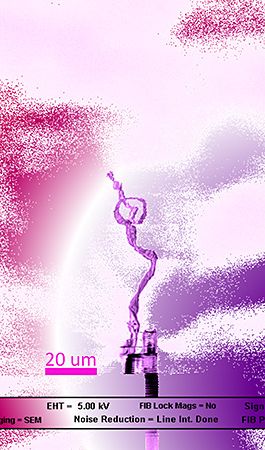Home > Press > The world's smallest trumpeter
 |
| Almost certainly the world's smallest Trumpeter |
Abstract:
Imagine how passionately this 0.00007 metre short musician blows his instrument toward the sky at dawn to make a sound with his tiny lungs. His full height is about the diameter of a thick human hair; the diameter of the trumpet tube is around about 0.0000001 metre (100 nanometres) and its length about 0.00001 metre (10 micrometres). This contender for the world's smallest standing statue of a musician has been fabricated as a part of a Nanotechnology MSc student project at the London Centre for Nanotechnology (LCN).
The world's smallest trumpeter
London | Posted on July 2nd, 2009"This sculpture happened to appear during advanced silicon etching (ASE®) with high-tech "plasma" process in a vacuum chamber. Therefore, his "chamber" music could not be transmitted physically via vacuum outside his room, unfortunately," says project supervisor, Dr Takashi Matsuura.
This student project aimed at both nanofabrication of three-dimensional artificial structures with plasma technologies and their engineering applications. The project's objective is the demonstration of nanostructure fabrication capability over a few tens centimetre wide area - this is quite challenging as the dimensional dynamic range spreads over millions. Refining the nanofabrication process further by incorporating artistic sensibilities would draw wider public interest in nanotechnologies.
In addition to the diminutive musician, "a frosty glass for a pint of beer" (*) and "Seabed creatures" (*) have been created by a former MSc student Mr Henry Crawford during his experiments on plasma process optimisation. Although colorful and complex images are widely spread in the recent Nanoart world, this type of simple and monochromatic three-dimensional (3D) sculptures are more reminiscent of classical sculpture and artwork.
"These kinds of novel 3D nanostructures are very interesting. The project also involves the study of the basic reaction mechanisms occurring at the atomic scale in the reaction schemes. It may also be possible to apply the fabricated structures to prototype test devices and to new device idea," says co-supervisor Prof. Ian Boyd.
Plasma is gas excited by radio frequency electric power into a complex mixture of ionized atoms and molecules as well as electrons and neutral radicals. A familiar example of plasma is one generated inside a fluorescent tube when it is turned on. More sophisticated plasma with particular reactive gases can conduct this type of fabrication in a carefully-designed vacuum chamber within state-of-the-art instruments.
Plasma processing is currently the favoured tool for fabricating three-dimensional nanostructures in planar technology, such as silicon integrated circuit technology, enabling the possibility of fabricating a wide variety of novel electronic, medical and MEMS devices. The plasma approach has the dual advantage of inducing directional chemical reactions due to linear acceleration of the ions produced by the bias voltage, and of lowering reaction temperatures due to the plasma-generated reactive species.
"Some may find humor in this news as 'blowing your own trumpet' in English slang may mean exaggerating, but I hope this report is received with general acceptance," adds Dr Takashi Matsuura.
####
About London Centre for Nanotechnology
The London Centre for Nanotechnology, LCN, is a UK based multidisciplinary enterprise operating at the forefront of science and technology. It is a joint venture between University College London and Imperial College London and is based at the Bloomsbury and South Kensington sites. It has a unique operating model that accesses and focusses the combined skills of the departments of chemistry, physics, materials, medicine, electrical and electronic engineering, mechanical engineering, chemical engineering, biochemical engineering and earth sciences across the two universities.
The Centre occupies a purpose-built eight storey facility in Gordon Street, Bloomsbury, as well as extensive facilities within different departments at South Kensington. LCN researchers have access to state-of-the-art clean-room, characterisation, fabrication, manipulation and design laboratories. This experimental research is complemented by leading edge modelling, visualisation and theory.
For more information, please click here
Contacts:
Bloomsbury (UCL) Site
London Centre for Nanotechnology
17-19 Gordon Street
London WC1H 0AH
tel: +44 (0)20 7679 0604
fax: +44 (0)20 7679 0595
Copyright © London Centre for Nanotechnology
If you have a comment, please Contact us.Issuers of news releases, not 7th Wave, Inc. or Nanotechnology Now, are solely responsible for the accuracy of the content.
| Related Links |
| Related News Press |
News and information
![]() Simulating magnetization in a Heisenberg quantum spin chain April 5th, 2024
Simulating magnetization in a Heisenberg quantum spin chain April 5th, 2024
![]() NRL charters Navy’s quantum inertial navigation path to reduce drift April 5th, 2024
NRL charters Navy’s quantum inertial navigation path to reduce drift April 5th, 2024
![]() Discovery points path to flash-like memory for storing qubits: Rice find could hasten development of nonvolatile quantum memory April 5th, 2024
Discovery points path to flash-like memory for storing qubits: Rice find could hasten development of nonvolatile quantum memory April 5th, 2024
Announcements
![]() NRL charters Navy’s quantum inertial navigation path to reduce drift April 5th, 2024
NRL charters Navy’s quantum inertial navigation path to reduce drift April 5th, 2024
![]() Discovery points path to flash-like memory for storing qubits: Rice find could hasten development of nonvolatile quantum memory April 5th, 2024
Discovery points path to flash-like memory for storing qubits: Rice find could hasten development of nonvolatile quantum memory April 5th, 2024
|
|
||
|
|
||
| The latest news from around the world, FREE | ||
|
|
||
|
|
||
| Premium Products | ||
|
|
||
|
Only the news you want to read!
Learn More |
||
|
|
||
|
Full-service, expert consulting
Learn More |
||
|
|
||








